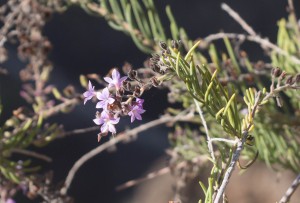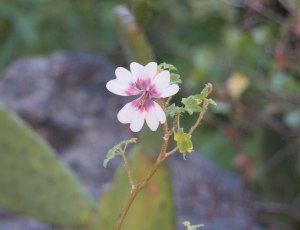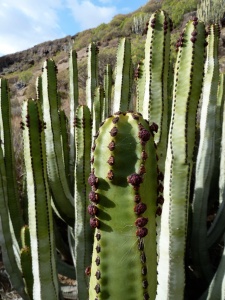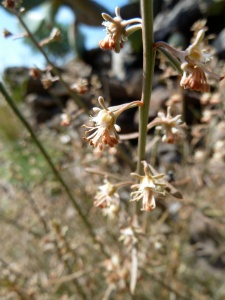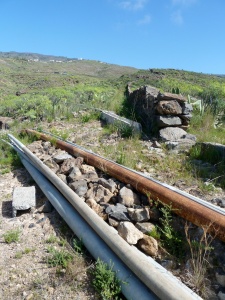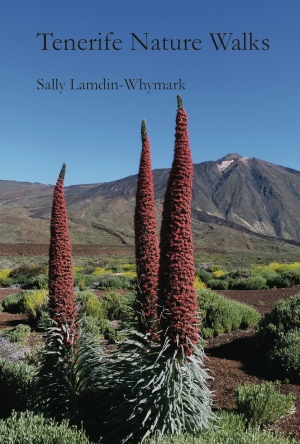The Barranco de Erques is the border between the municipalities of Guia de Isora and Adeje on the west of Tenerife. The whole of its length is in protected areas, most of it in the Protected landscape of the Barranco de Erques (Paisaje protegido del Barranco de Erques). It is a very scenic barranco, but also interesting botanically, especially where an old pathway crosses it just above the bridge for the main road from Adeje to Guia de Isora (TF-82).
We did this walk to use two traditional paths on the inventory by the Ayuntamiento of Guia de Isora (Town council) which I had never walked. I knew one, the Camino La Morra, went alongside the Barranco de Erques for part of its trajectory, and was interested to see what it was like.

The pink flowers of the Sea rosemary (Campylanthes salsaloides) in front of the bright green of the Bitter spurge (Euphorbia lamarckii) in flower.
We parked beside the TF-82 on the Adeje side of the bridge and walked down to the bridge. Behind the crash barrier a path leads to the right and up some rudimentary stone steps up a slope to join the old path disrupted by the building of the TF-82 road. The path leads along the Adeje edge of the barranco, and uphill a little before beginning the descent into the barranco on a well-cobbled path. There are a lot of Euphorbias here, but, unusually, there are three species together, which normally grow in different habitats. There is the species that is common in coastal areas, the Sweet spurge (Euphorbia balsamifera), the Bitter spurge (Euphorbia lamarckii) common in mid altitudes, and the Purple spurge (Euphorbia atropurpurea) which normally grows only higher up the mountains. The altitude here is around 450m above sea level, so I suppose it is a mixing point.

Purple spurge, (Euphorbia atropurpurea) a canary endemic which grows normally at higher altitudes around 800-1200m
The path climbing the opposite side of the barranco was, in places, badly eroded and somewhat overgrown so needed some care, but at the top we reached a reasonably clear, though rough, path going straight up to the right. We walked up this path for about 500m and I noticed a clump of Canary mignonette (Reseda scoparia). This is again a plant of coastal areas but it seemed quite at home here. We were approaching a dip in the path to cross a minor barranco when we reached the junction to the right for the start of the Camino La Morra which would take us back to the edge of the Barranco de Erques and then along its edge for a while on the way to Vera de Erques.
Vera de Erques is quite a substantial community with its own primary school, church and cultural centre. It is surrounded by good farmland, and at this time of year many blossoming almond trees. We arrived on the main street opposite the cultural centre, and turned left downhill till we reached a bend where the next footpath leaves. There is a signboard describing the Camino de Montiel at the start, which is a track at first, but after about 10 metres it is important to look for the footpath going down, concreted at first as it also allows access to a small allotment. Before you reach the allotment the main path goes right and from then on it is very easy to follow.
The Camino de Montiel passes a house of the same name on its way to Las Fuentes, a small village which is reached only by a dirt track, but which used to be a very important area for growing cereals for Guia de Isora. These days the houses are largely uninhabited, although some are used at weekends and in the summer by the families that own them. Many of the fields are still cultivated by the families, and once every 5 years the village has a fiesta in March when all the families gather up there for a weekend. I have never seen so many people up there as I did when the last fiesta happened in 2010.
We did not go right up to Las Fuentes this time, but joined the track where the footpath comes close to it, and walked down the track to Tejina de Guia. There we went left along the road for a short distance, crossing the beautiful Barranco Cuéscara, and then turning right off the road to rejoin a path for a while. That path ended on the road from TF-82 and Vera de Erques which we had to walk along for about 500m before reaching a path again leaving on a bend. This path took us back to the junction with the Camino la Morra where we had turned earlier and we followed the same route back down to and across the Barranco de Erques, taking more time to enjoy the flowers as we crossed it back to the cars. There were lots of Sea Rosemary (Campylanthus salsaloides) plants with their pink flowers. There are also some fine clumps of Cardón, or Canary spurge, (Euphorbia canariensis) on the barranco sides. Also in this area, though not in flower at this time of year (April/May would be the time for them) are some uncommon shrubs of the Canary endemic Shrubby Bindweed (Convolvulus scoparius).
The walk was 12.06 km /7.5ml long, involved 651m of ascent and descent, and took us 4hrs 25mins. A GPS track of the walk can be seen, and downloaded from, this site:
